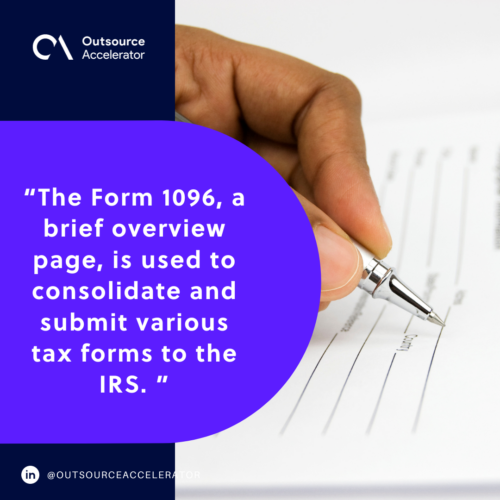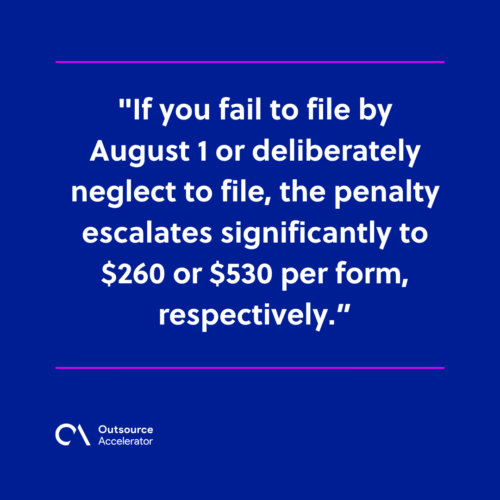Form 1096: A complete guide for employers

As a small business proprietor who collaborates with independent contractors, it is essential to understand the significance of filing Form 1099 and the potential requirement of accompanying it with Form 1096.
This informative article provides you with comprehensive answers to your pertinent questions regarding these forms.
What is Form 1096?
Form 1096, also recognized as the annual summary and transmittal of U.S. information returns, serves as a summary page for different IRS tax forms.
It comprises a compilation or summary page for various information returns you submit to the IRS, such as Forms 1099-MISC and 1099-NEC.

Importance of Form 1096
The significance of 1096 cannot be overstated.
The Form 1096, a brief overview page, is used to consolidate and submit various tax forms to the IRS.
For instance, if your company employs a contractor to design a website for $2,500 and a Form 1099 was created for the contractor, the IRS requires a copy of this 1099 form sent to them. This is accompanied with the Form 1096, in case the filing is done through regular mail.
Where can you get form 1096?
To acquire Form 1096, you may visit the IRS website to obtain official IRS information returns, including scannable copies for submission purposes.
By selecting “employer and information returns,” you can request specific forms and the instructions that go with them.
The requested materials, including any publications you may have ordered, will be mailed to you as soon as possible.
Steps in filling out Form 1096
Let us outline the step-by-step process involved in completing Form 1096.
Step 1: Furnish your business information
Commence by accurately entering all relevant business details on Form 1096. This includes your company name, address, and the total returns your business intends to file.
Step 2: Provide your personal information
This step entails supplying your particulars. Specifically, you are required to provide:
– Full name
– Phone number
– Email address
– Fax number
– Mailing address
– City
– State
– Country
– Zip code
There is also a designated section to include the contact details of your company’s accountant.
Step 3: Indicate your employer identification number (EIN) in box 1
Enter your Employer Identification Number (EIN) in Box 1 if applicable. However, if you do not possess an EIN, you should provide your Social Security number in Box 2 instead.
Step 4: Specify the number of forms in box 3
Accurately report the quantity of forms you intend to submit to the IRS. For instance, if you plan to file five 1099-MISC forms, indicate “5” in Box 3.
Step 5: Calculate your withheld federal income tax in box 4
Calculate and summarize the total amount of federal income tax withheld from all the filed forms.
Record this total in Box 4.
Step 6: Identify the specific return being submitted in box 6
One of the final steps entails indicating which information return you will submit to the IRS.
Use an “X” mark to designate the relevant information return on Form 1096.
It is important to note that certain forms require an accompanying Form 1096 when not utilizing e-filing. Examples include Forms W-2G, 1098, 1098-C, 1098-E, and various variations of Form 1099.
Step 7: Submit Form 1096 to the IRS
Once you have diligently completed Form 1096, file it to the IRS.
Before submission, verify the accuracy of all provided information and retain copies for your business records.
Form 1096 due date
The deadline for filing Form 1096 falls between January 31 and March 31. This due is contingent upon the method of filing selected and the relevant accompanying information included in the submission.
Failure to adhere to the deadline for filing Form 1096 may result in penalties. If you submit the form within 30 days after the due date, a penalty of $50 per form applies.
Subsequently, this penalty increases to $100 per form after that initial grace period. If you fail to file by August 1 or deliberately neglect to file, the penalty escalates significantly to $260 or $530 per form, respectively.
Prioritizing timely filing is essential to avoid these penalties and maintain compliance with IRS regulations.

Why outsourcing payroll is the answer to your tax pains
Payroll processing and tax obligations have proven confusing and difficult for many businesses. In one case, there are several tax codes as well as payroll rules that businesses must study and follow.
Maintaining compliance with many of these can be a major headache for many businesses.
Most businesses must decide whether to have an in-house payroll processor or outsource all their payrolls.
When businesses use payroll service providers, they save money on payment processing fees.
Furthermore, there are fewer risks associated with noncompliance and time savings because this provider handles administrative tasks such as data input, tax filing, and so on.







 Independent
Independent




